
 |
| Our subscribers' grade-level estimate for this page: 5th - 6th |
Illustrated Dictionary of Jewelry |
 |
||||||
| A | B | C | D | E | F | G | H | I | J | K | L | M | N | O | P | Q | R | S | T | U | V | W | X | Y | Z |
 MABE PEARL Mabe pearls are large, hemispherical cultured pearls that grow attached to the inside shells of oysters. Mabe pearls are used in earrings, pins, and rings. |
MACHINE STAMPING Machine stamping (also known as die-stamping) is a process in which sheet metal is cut and shaped between two dies, forming a pattern in relief. Two steel dies are used, the male die has the design in cameo (protruding); the female die has the design hollowed out. The male die is put on top of the metal, the female die is put on the underside of the metal. The press is forcefully brought down onto the dies and metal, forcing the metal into the shape of the mold. Many medallions and mass-produced jewelry findings are made this way. |
MADDUX, VEGA Vega Maddux was a jewelry designer from California in the late 1960s (she died in 1997). Maddux 's striking necklaces, rings, earrings, and bracelets include semi-precious stones and creamy enamel work, often with striking abstract forms, flowers or butterflies. |
 MAHOGANY OBSIDIAN Mahogany Obsidian (also called Apache tears) is brownish obsidian. This glassy, lustrous mineral is found in lava flows, and obsidian stones can be massive. Obsidian is formed when viscous lava (from volcanos) cools rapidly. Most obsidian is 70 percent silica. Obsidian has a hardness of 5 and a specific gravity of 2.35. The pin above is Mahogany (brown) obsidian. |
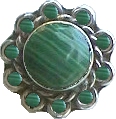 MALACHITE Malachite is an opaque semi-precious stone with layers of deep green and light green. It is usually found in copper mines; malachite is about 57% copper. Malachite was used as jewelry thousands of years ago by the ancients Egyptians. Malachite is usually cabochon set in silver. Russian malachite carvings were done in miniature and in large scale; malachite was also inlaid in furniture. Malachite has a hardness of 4 and a specific gravity of 3.80. It is monoclinic; it has one two-fold axis of symmetry. Malachite is sometimes coated with colorless wax, oil, or hardening agents to increase its durability and enhance its appearance. |
MALLEABLE Malleable metals are easily worked with a hammer or a roller. gold and sterling silver are very malleable metals. |
 MALTESE CROSS Maltese cross is a cross whose four equal-length arms get larger the farther they get from the center. The Maltese cross brooch above is by Weiss; it has red paste stones and a Japanned finish. |
MANDREL A mandrel is a metal rod used to coil molten glass in order to make a bead. |
MARBOUX Marboux is a mark of the Marcel Boucher costume jewelry company. Other Boucher marks include "Marcel Boucher" and "Boucher." |
 MARCASITE Marcasite is a shiny, metallic semi-precious stone. It is actually iron pyrite. Marcasite is generally faceted. The Czech guilloche pin above is studded with marcasites. |
 MARQUISE Marquise cut stones have a shape like an oval with two pointed ends. |
 MARVELLA Marvella is a costume jewelry brand that was founded by Sol E. Weinreich, who began business in January, 1906 in New York, New York. They were bought by Trifari in 1982. It is now owned by the Monet Group, Inc. This company has been called the Weirich Brothers Company, Marvella, Inc., and Marvella Pearls, Inc. Marvella created costume jewelry, many featuring simulated pearls and faceted beads. For more information on Marvella, click here. |
MATINEE-LENGTH A matinee-length necklace is a single strand that is from 22 to 23 inches (56 to 58 cm) long. Matinee-length generally refers to a string of pearls that hangs to the top of the cleavage. |
 MATISSE Matisse is a line of enameled copper jewelry from the "Renoir of California" jewelry company. The enameled copper leaf pin above is marked Matisse. |
MATTE FINISH A matte finish on a metal's surface is a soft, lustrous finish that reduces the metal's reflectivity. |
MAW-SIT-SIT Maw-sit-sit is a rare green gemstone that has dark-green to black veining; it sometimes has white spots. The stone is opaque to translucent. Maw-sit-sit has a hardness of 6.0; the specific gravity is 2.5 to 3.5. This stone is found in Maw-sit-sit, Myanmar (Burma), and is often found neat jadeite, but maw-sit-sit is not a type of jade. Maw-sit-sit was first identified in 1963 by the Swiss Gemologist Eduard Gübelin; the local called the stone maw-sit-sit, and the name was retained. Although its exact composition is still unknown, Maw-sit-sit is composed of chromite, ureyite, chrome jadeite, symplektite, chrome amphibole, and other lighter minerals. |
 MAZER (Mazer (or Jomaz) is a costume jewelry mark used by the Joseph J. Mazer company (founded in NY, NY in 1927). Early pieces are marked "Mazer Bros;" later pieces are marked JOMAZ or MAZER. They went out of business in 1970's. Mazer made high-quality jewelry like the gold-plated earring above with pearl and paste accents. |
McCLELLAND BARCLAY McClelland Barclay was a costume jewelry company that made very high quality pieces, often gold plated with colored rhinestones and a geometric design. He also made jewelry pieces in sterling silver and trays in anodized aluminum and bronze. McClelland Barclay (1891-1943) was an artist who was an illustrator, sculptor, painter, and jewelry designer. McClelland Barclay jewelry is not the same as Barclay. |
MELEE A melee is a small diamond, under .20 carat. |
MEMORY WIRE Memory wire is a tough, stiff wire that retains its shape. It is often used for necklaces and bracelets. |
MEXICAN DIAMOND Mexican diamond is a misleading term for rock crystal, and not a diamond at all. |
MEXICAN JADE Mexican jade is a misleading term for dyed stalagmitic calcite; it is not jade. |
MFA MFA stands for the Museum of Fine Arts in Boston, Massachusett, USA. They produce reproductions of their museum pieces (and other jewelry pieces). |
MICA Mica is a soft, lightweight, transparent mineral that cleaves into thin, elastic sheets (it has a single perfect cleavage direction). It is used for lampshades and electrical insulators. There are about 30 different types of micas, ranging in color from yellow to green to gray to violet to white to brown. Mica has a hardness of 2.5 and a specific density of about 3. Tiny mica particles give the shimmer to aventurine (goldstone). |
MILLEGRAIN A millegrain (or millegrain setting) is a setting in which the stone is secured by tiny beads [grains] of metal or a band of metal that is decorated with tiny beads of metal. |
MILLING Milling is a process in which wood or metal is cut while it either the material or the tool is spinning. Symmetrical shapes and patterns are cut into the material. |
MINE CUT Mine cut stones have a cushion-shaped girdle. This type of cut was popular in the late 1800's. |
MING'S Ming's of Honolulu (Hawaii) was a fine jewelry company that sold high-quality jewelry (both gold and silver), often using pearls, jade, coral, and ivory (often dyed). The designs often used Hawaiian and Asian motifs. Ming's also produced hand-carved figurals depicting exotic leaves (like banana leaves), flowers (like hibiscus, anthurium, pikake, bird of paradise, and orchids) and other natural objects. Some older, unmarked Ming's pieces have a distinctive leaf-shaped clasp. The artist Wook Moon began Ming's in 1940 and the store soon expanded over the Hawaii islands, and to San Francisco, New York City, Miami, Houston, Ft. Lauderdale, and Atlanta. The last of the Ming's stores (in Honolulu) closed in October, 1999. |
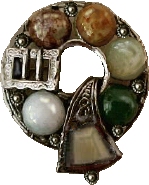 MIRACLE Miracle makes Celtic or "Scottish" jewelry, jewelry using ancient Celtic designs and stones such as agate. The Miracle pin pictured above is made with agate stones. |
MIXED CUT A mixed cut in one in which the style of the facets above and below the girdle are different. A standard mixed cut is brilliant cut above and step cut below. |
MOGUL EMERALD These Indian emeralds were owned by Indian moguls (like Shah Jahan, the builder of the Taj Mahal) and were inscribed with sacred blessings. |
MOHS SCALE The Mohs Scale of Hardness measures a substance's hardness, that is, how resistant it is to being scratched. In the Mohs scale, which ranges from 1 to 10, one substance is harder than another if it can scratch it. For example, a diamond (hardness = 10) will scratch garnet (hardness = 6.5-7.5), but not the other way around, so a diamond is harder than garnet. This scale was invented by Austrian mineralogist Friedrich Mohs (1773-1839). |
MOINI, IRADJ Iradj Moini is a modern jewelry designer who produces exquisite, imaginative, handmade pieces. Moini's jewelry is highly collectible and is usually figural and studded with brightly-colored stones. Moini designs for Oscar de la Renta, but he has also produced pieces for Bill Blass, Scaas and Herrera. |
MOISSANITE Moissanite is a very hard mineral that was discovered by Dr. Ferdinand Henri Moissan (1852-1907), a French chemist and Nobel Prize winner (Moissan did work on synthesizing diamonds and discovered carborundum in 1891). He found tiny amounts of Moissanite in the iron meteorite that was found at Diablo Canyon (also called Meteor Crater) in Arizona, USA. Moissanite ranges in color from colorless to blue to green to yellow. Its chemical makeup is Silicon Carbide (SiC); it is also called Carborundum. Moisannite crystals are transparent to translucent. Moissanite has a hardness of 9.25 (this is almost as hard as diamond) and a specific gravity of 3.1 - 3.2. Laboratory-grown Moissanite is sold as a gemstone. |
MOKUME-GANE A Japanese metal-smithing technique which results in a wood-like finish. Alternating layers of thin, colored metals are laminated together. Patterns are punched in the laminate, filed away or hammered. This technique produces unique and delicate patterns. |
MOLDAVITE Moldavite is a rare, glassy, translucent, dark green gemstone. Moldavite is a silica-based tektite, a mineral formed when a meteorite (a rock from space) struck the Earth's surface and melted and fused the surrounding rock. Moldavite is only found in Bohemia (the Czech Republic) in the Ries Crater in the Moldau River valley (which it was named for). Moldavite was discovered in the late 1800's; the meteorite from which it formed hit the Earth about 14.7 million years ago. Moldavite has a hardness of 5.5-6.6. Inclusions of gas bubbles and iron/nickel spherules are common. This natural glass has been used for jewelry, religious articles, and decorative objects since prehistoric times. |
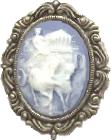 MOLDED CAMEO Molded cameos are cameos that are made by the molding process and not by carving the material (as traditional cameos are). Molded cameos are usually made from plastic, glass, or porcelain that is formed in a mold. Often, two colors of material are used, one for the relief pattern (often depicting a person or scene) and another for the background. The molded cameo above is a Jasper ware porcelain cameo made by the Wedgewood Company. |
MOMA MOMA stands for the Museum of Modern Art in New York City, New York, USA. They produce reproductions of their museum pieces (and other jewelry pieces). |
 MONET Monet is a major, high-quality costume jewelry manufacturer. It was founded as the Monocraft Products Company in 1927 by Jay and Michael Chernow as a monogram manufacturer and began producing jewelry under the name Monet in 1929. The mark "Monet" was begun in September, 1937. Monet produced Yves Saint Laurent jewelry in the 1980's. Monet developed the very comfortable "friction ear clip" for non-pierced earrings and the "barrel clutch" for pierced earrings. This company has been sold many times (its owners have included General Mills and Crystal Brands Jewelry) and is now called the Monet Group, Inc.; it is still located in East Providence, Rhode Island. The Monet Group now distributes jewelry under the names Monet, Trifari, Ciani, and Marvella. |
MONOCLINIC Monoclinic minerals have a crystalline structure in which there is one two-fold axis of symmetry. Jade, Malachite and moonstone are monoclinic. |
MONTANA RUBY A "Montana ruby" is actually a pyrope garnet (and not a ruby at all). |
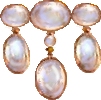 MOONSTONE Moonstone (orthoclase) is a semi-translucent stone that is made of albite and orthoclase feldspar. It is usually whitish-blue, but can be colorless, yellow, orange, gray, or even reddish. Moonstone is usually set as a cabochon. Moonstone was very popular early in the 20th century and was extensively used in Art Nouveau jewelry. Moonstone has a hardness of 6 and a specific gravity of 2.57. It is monoclinic; it has one two-fold axis of symmetry. Adularia is a common type of moonstone. Oligoclase is another type of moonstone; Labradorite and albite are rare forms. |
MORGANITE Morganite is a transparent to translucent pink gemstone. It is a variety of beryl, Be3Al2(Si6O18) that contains some manganese (giving the stone its pink color). Morganite has a hardness of 7.5 - 8 and a specific gravity of 2.71 - 2.90. It has poor cleavage and is brittle. Morganite is often heat treated to give the stone a purer pink color (and remove any yellow spots). Morganite was named for J. Pierpoint Morgan, the American industrialist and gem collector. Morganite is found in Brazil, Madagascar, Italy, Pakistan, Mozambique, Namibia, Zimbabwe, and the USA (California, Maine, Connecticut, and North Carolina). |
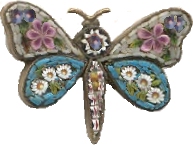 MOSAIC Mosaics are pictures or decorations that are made out of small pieces (tiles) of stone, glass or other materials. Italian mosaics were common souvenirs. Older examples are much more intricate, have smaller mosaic tiles, and generally have better workmanship. |
MOSS AGATE Moss agate (also called Mocha stone in Britain and the USA) is a green variety of agate. It is chalcedony that has dendritic (tree-like) inclusions of green (red or black) hornblende. The inclusions often form beautiful patterns. Moss agate has a hardness of 6.5-7 and a specific gravity of 2.6. Green moss agate is found in India, and some other locations. |
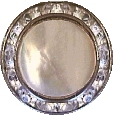 MOTHER-OF-PEARL Mother-of-pearl is the iridescent coating on the inside of oyster shells. Mother-of-pearl is used for jewelry, buttons, and other uses. |
MOUKAITE Moukaite is a semi-precious gemstone, a variety of jasper from Australia. The color of moukaite varies from red-browns to pinks, with gold and white bands. |
MOURNING JEWELRY Mourning jewelry is a type of jewelry worn when one is mourning the loss of a loved one. It is often black, subdued jewelry (often made of jet or black glass and metal with a Japanned finish) or jewelry that commemorates the dead (like hair jewelry or cameos). After England's Queen Victoria's beloved husband (and cousin) Albert died (in 1861), she went into an extended period of mourning. During these years, she wore black clothing and mourning jewelry. English fashion was greatly influenced by this, and mourning jewelry, especially jet, became quite fashionable. |
MYA YAY Mya yay is the Burmese (Myanmar) name for the highest quality translucent jadeite. |
 MYSTIC FIRE Mystic fire (also called mystic topaz or rainbow topaz) is topaz that has been color enhanced by coating it with a fine layer of metal atoms (in a process called vacuum deposition). This stone has red, green, violet, and blue streaks. Mystic fire has a hardness of 8. |
Illustrated Dictionary of Jewelry |
 |
||||||
| A | B | C | D | E | F | G | H | I | J | K | L | M | N | O | P | Q | R | S | T | U | V | W | X | Y | Z |
Enchanted Learning®
Over 35,000 Web Pages
Sample Pages for Prospective Subscribers, or click below
|
Overview of Site What's New Enchanted Learning Home Monthly Activity Calendar Books to Print Site Index K-3 Crafts K-3 Themes Little Explorers Picture dictionary PreK/K Activities Rebus Rhymes Stories Writing Cloze Activities Essay Topics Newspaper Writing Activities Parts of Speech Fiction The Test of Time
|
Biology Animal Printouts Biology Label Printouts Biomes Birds Butterflies Dinosaurs Food Chain Human Anatomy Mammals Plants Rainforests Sharks Whales Physical Sciences: K-12 Astronomy The Earth Geology Hurricanes Landforms Oceans Tsunami Volcano |
Languages Dutch French German Italian Japanese (Romaji) Portuguese Spanish Swedish Geography/History Explorers Flags Geography Inventors US History Other Topics Art and Artists Calendars College Finder Crafts Graphic Organizers Label Me! Printouts Math Music Word Wheels |
Click to read our Privacy Policy
| Search the Enchanted Learning website for: |